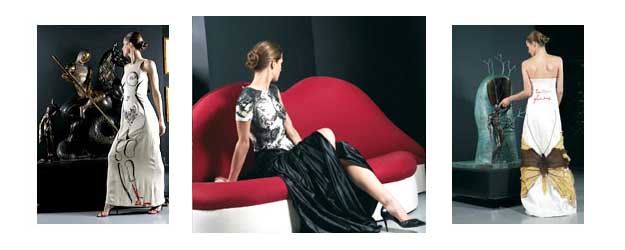
All his life Salvador Dalí had a great interest for the world of fashion. His meeting with Coco Chanel inspired him to design clothing, such as the costumes the theatrical piece, Bacchanale, and for the opera, Tristan Fou.
In 1950 he created, with Christian Dior the special Costume for 1945 with drawers.
He also designed jewellery for women : The Eye of time (1949) based on the Persistence of Memory, and Rubis’ Lips (1950) based on the Mae West’s Lips Sofa. In 1981 his piece, “Apparition of the Face of the Aphrodite of Knidos in a landscape”, inspired him to make the bottles for the perfume Salvador Dalí Homme et Femme.
According to Dalí, art should invade life. He thus became interested in interior furnishings after meeting the famous interior designer Jean-Michel Franck.
In 1934-1935, Dalí produced, from a photographic portrait of Mae West, a gouache with the title : Face of Mae West which can be used as a surrealistic apartment. Also presented here is the Salon vis à vis de Dalí et Gala, which recreated the master’s projects going back to 1935-1937, such as the Lamp with drawers and the Lamp stand with crutches (produced from sketches made around 1936-1937).
For the interior he also designed a tableware series in Vermillon (1962).
Dalí, Schiaparelli, Fashion
“The constant tragedy of life is fashion and that is why I have always liked to collaborate with (…) Madame Schiaparelli, just to prove that the idea of dressing oneself, the idea of disguising oneself, was only the consequence of the traumatic experience of birth, which is the strongest of all the traumas that a human being can experience, since it is the first.” Salvador Dalí
Cocteau, Eluard, Magritte and Man Ray introduced Dalí to high society in the 1930s. Through them, he met Elsa Schiaparelli, the Italian fashion designer who was close to artists from the Dada and surrealist movements. Schiaparelli was very creative and conceptual, and did not consider designing as a profession but as “a very difficult and frustrating art, for as soon as a dress is born, it belongs to the past. A dress cannot be hung on the wall like a painting.”
Schiaparelli’s work with Salvador Dalí was the most fruitful of all of her collaborations with artists. Actually, Dalí was interested in all aspects of fashion since the 30s. As for Schiaparelli, she liked visual games, even to the point of being absurd questionings our perception of reality. In 1932, even the New Yorker said that “A frock from Schiaparelli ranks like a modern canvas.”
Schiaparelli’s winter 1936-1937, collection presented in August 1936, was their first official collaboration, although it was obvious that Dalí knew everything about the designer’s work since 1935.
Dalí’s Anthropomorphic Cabinet (1936), whose torso is a chest of drawers, inspired a Schiaparelli suit designed the same year, whose pockets, either real or in trompe l’oeil, were shaped like boxes and the buttons were drawer knobs.
The idea for the famous Shoe-Hat came from a photo of Dalí standing with a shoe on his head that was taken by Gala.
The Lobster Dress from 1937 is another iconic piece from the collaboration between Schiaparelli and Dalí. Dalí drew an immense blood-red lobster on a plain white organdy evening gown, that was highly symbolic of his obsession with sex. The new Duchess of Windsor, the sultry Wallis Simpson, immediately wore it for photographer Cecil Beaton (Vogue 1937), without realizing that this “Dalinian fig leaf” would accelerate her royal spouse’s abdication.
Dalí spoke about lobsters : “Like lobsters, young girls have a delightful exterior. Like lobsters, they turn red when you get them ready to eat.”
The Tears Dress, which is part of the Circus Collection from 1938, was inspired by the painting, Three Young Surrealist Women Holding In Their Arms The Skins Of An Orchestra. The dress has a trompe l’oeil pattern that looks like torn pieces of fabric. It is a mourning dress that comes with a long veil.
Beyond clothing, Dalí continued his collaboration with Elsa Schiaparelli by imagining patterns for fabric and perfume bottles, such as the labels for Shocking Radiance body oils and the Baccarat crystal bottle for her fragrance, Le Roy Soleil in 1946.
According to Dalí, Paris of the 1930s was symbolized “not by the surrealist polemics in the café on the Place Blanche, or by the suicide of my great friend, René Crevel, but by the dressmaking establishment which Elsa Schiaparelli was about to open on the Place Vendôme. Here new morphological phenomena occurred ; […] here the tongues of fire of the Holy Ghost of Dalí were going to descend” (The Secret Life of Salvador Dalí, 1942).
Sources
Elsa Schiaparelli, Dilys E. Blum, 2004
The Secret Life of Salvador Dalí, Salvador Dalí, 1942
The Little Book of Schiaparelli, Emma Baxter-Wright, 2012
Learn more at :http://www.schiaparelli.com/fr/maison-schiaparelli/schiaparelli-et-les-artistes/